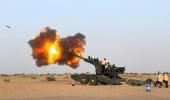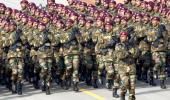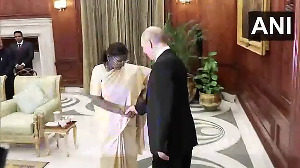When the internal security situation spirals out of the control of the provincial law and order machinery, the CAPFs can be called in, providing a security buffer before the Army is deployed.

In the Union Budget on July 23, the central government allocated Rs 6.21 trillion (about $75 billion) to the four wings of the military -- the Army, Navy, Air Force, and Coast Guard -- for 2024-2025.
Separately, the Budget also allocated Rs 96,792 crore -- almost Rs 1 trillion -- for the slightly over 1 million men and women who constitute the seven Central Armed Police Forces (CAPFs).
The CAPFs, which fall under the jurisdiction of the ministry of home affairs, include the Central Reserve Police Force (CRPF), National Security Guard (NSG), Border Security Force (BSF), Indo-Tibetan Border Police (ITBP), Central Industrial Security Force (CISF), Assam Rifles (AR) and the Sashastra Seema Bal (SSB).

Under the One Border, One Force principle, the BSF is responsible for the borders with Pakistan and Bangladesh, the ITBP safeguards the India-China border, the SSB oversees the borders with Nepal and Bhutan, and the AR mans the border with Myanmar.
The Indian Army provides robust support to the BSF in safeguarding the Line of Control -- the active section of the India-Pakistan border in Kashmir. Similarly, the Army assists the ITBP in defending the Line of Actual Control with China.

The CAPFs are often erroneously referred to as 'paramilitary forces'. Paramilitary forces are armed police with their rank and file, led by officers on temporary deputation from the regular military. By that definition, only the AR is a paramilitary force.
The CAPFs are the penultimate intervention force of the central government.
When the internal security situation spirals out of the control of the provincial law and order machinery, the CAPFs can be called in, providing a security buffer before the Army is deployed.
This provides the central government with sizeable police forces such as the 313,634-strong CRPF and the 265,000-strong BSF, each with over a quarter of a million personnel.
Alongside them are smaller forces, such as the 163,590-strong CISF and the 90,000-strong ITBP.
During wartime, the CAPFs can be vital in ensuring security in the rear areas, roads and highways, and logistic installations behind the tactical battle area.

Capital allocation as a percentage of the defence budget
The defence budget has been criticised over the years for being short on capital allocations (the part of the Union Budget that pays for equipment modernisation) and long on personnel expenditure.
An examination of annual capital allocations over the past seven years reveals that the capital budget, as a percentage of the overall budget, has remained static between 25 per cent and 30 per cent.
Modern military powers spend more than 50 per cent of their budgets on state-of-the-art weaponry and electronics, ensuring a battle-winning technological advantage in combat.
Feature Presentation: Rajesh Alva/Rediff.com











